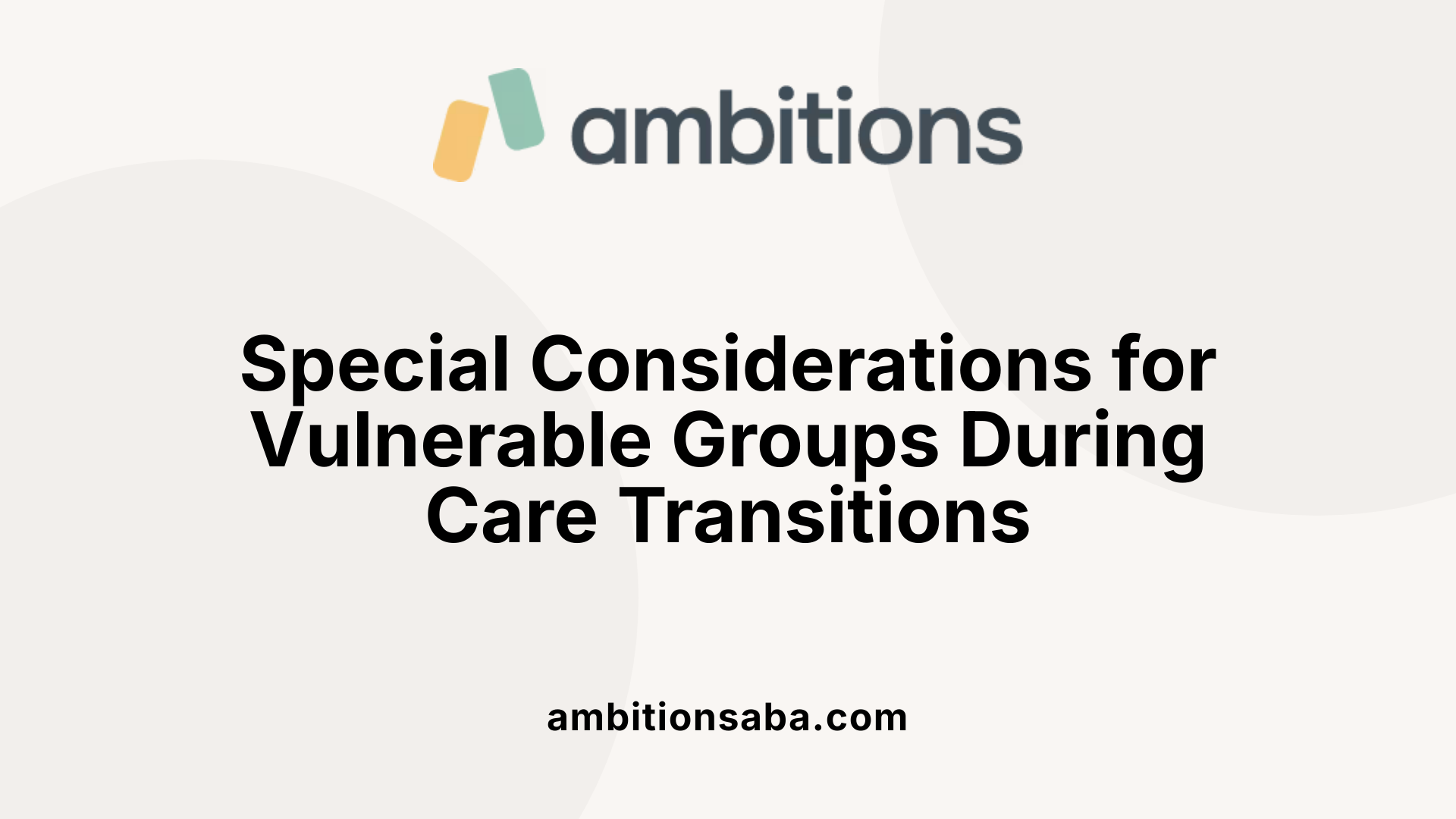Empowering Nonverbal Communication: Leveraging ABA Therapy for Children with Autism
Introducing the Critical Role of Supporting Transitions across Settings and People
Transitions in care are crucial junctures where patients move between different healthcare settings, community services, and support networks. This phase, if poorly managed, can lead to adverse outcomes, increased healthcare costs, and diminished patient well-being. Supporting these transitions effectively involves a comprehensive, collaborative approach that encompasses evidence-based models, targeted strategies, interprofessional teamwork, and policies that prioritize patient safety and continuity of care. This article explores the core frameworks, practical strategies, and innovative practices essential for fostering seamless and safe transitions across diverse populations and settings.
Foundational Frameworks for Care Transitions

What are care transition models?
Care transition models are structured approaches designed to ensure safe, effective, and coordinated movement of patients between different healthcare settings. These models aim to address common gaps such as communication failures, medication errors, and avoidable readmissions. Examples include the Transitional Care Model (TCM), Coleman Care Transitions Intervention (CTI), and Community-Based Transition Model (CBTM). They focus on personalized care planning, patient education, medication management, and follow-up support. Implementing these models has been shown to improve health outcomes, especially for high-risk groups like older adults and those with chronic conditions.
What are the four pillars of care transition?
The four pillars serve as the foundation for successful care transitions. They include:
- Medication Self-Management: Patients need clear instructions on medications, potential interactions, and adherence strategies.
- Personal Health Record (PHR): A comprehensive, easily accessible document that tracks medications, allergies, instructions, red flags, and questions.
- Timely Follow-up: Scheduling and ensuring follow-up appointments with primary or specialty care providers shortly after discharge.
- Awareness of Red Flags: Recognizing warning signs of health deterioration and knowing how to respond.
Support from a Transition Coach, typically an advanced practice nurse or registered nurse, is vital. The coach educates the patient before discharge, often conducts home visits, and supports the patient during the critical first month at home.
Role of the Transition Coach
The Transition Coach plays a pivotal role in helping patients navigate complex care transitions. They provide education about medications, symptoms to watch for, and the importance of follow-up care. Through visits and phone calls, often within the patient’s home, the coach promotes understanding, adherence, and confidence. This support reduces complications and readmissions, particularly for vulnerable populations such as those in skilled nursing facilities or with multiple chronic conditions. The coach’s involvement creates a safety net, empowering patients to manage their health effectively and ensuring continuity of care during vulnerable transition periods.
Understanding the Types of Life Transitions
Life transitions refer to significant changes in an individual’s life that can happen in various forms. These include anticipated transitions, such as graduating from school, getting married, having children, or retiring. These events are often planned for and expected over time, allowing individuals to prepare psychologically and practically.
Unanticipated shifts, on the other hand, happen suddenly without warning. Examples include losing a job unexpectedly, experiencing a sudden illness, or undergoing a breakup. These unexpected changes require quick adaptation and can be more challenging due to their unpredictable nature.
Another important category is sleeper transitions, which are subtle or gradual changes that lack obvious triggers. These may encompass aging processes, creeping health issues, or slowly changing social roles. Because they develop gradually, they might be less noticeable initially but can have profound long-term effects.
A critical aspect of all types of transitions is how they impact personal identity. Transitions often raise questions about who individuals are and who they want to become. They may lead to a period known as the 'neutral zone,' where old identities are shed, but new ones have not yet fully formed. This in-between state can be confusing or unsettling.
Understanding these differences helps in recognizing that change is not just external but deeply psychological. Navigating transitions successfully involves awareness of these phases, embracing the process with curiosity and support. Techniques like coaching and reflective practices can facilitate adaptation, foster resilience, and support individuals in living purposefully through ongoing change.
Overall, life transitions are a natural part of human experience, requiring time, reflection, and adaptive strategies to manage effectively. Recognizing their types and impacts can empower individuals to face life's inevitable shifts with greater confidence and resilience.
Strategies for Facilitating Smooth Care Transitions
What are effective strategies to facilitate smooth care transitions?
Smooth care transitions are vital for improving health outcomes and reducing hospital readmissions, especially among vulnerable populations like older adults and children in care. Employing several key strategies can make these transitions safer and more manageable.
One fundamental approach is providing advance notice about upcoming changes. Clearly informing patients or children and their caregivers about what to expect helps reduce confusion and anxiety. For example, using visual cues or simple explanations about the next steps allows individuals to prepare mentally and emotionally for the transition.
Structured planning is another essential element. This involves comprehensive assessments to understand the individual's needs, preferences, and potential barriers. Models like the Transition Passport and other planning tools enable personalized preparation, ensuring that support is tailored to each person’s unique situation. These assessments cover areas such as healthcare requirements, daily routines, and emotional readiness.
Educational tools also play an important role. For children, especially those with special needs such as ASD, visual schedules, timers, and first/then cards help visualize routines and expectations. For adults, patient education about medication management, follow-up appointments, and warning signs enhances self-management skills.
Visual aids are particularly effective in fostering independence and understanding. Timers, countdowns, and pictorial instructions make abstract concepts like time and schedule changes tangible. For children with autism, visual supports like social stories or picture schedules decrease challenging behaviors and increase compliance.
Finally, involving all stakeholders in collaborative planning ensures a holistic approach. Healthcare providers, family members, teachers, and caregivers work together to create consistent routines and share information. This team-based effort ensures that everyone understands their roles, contributes to care decisions, and supports the individual through the transition.
In summary, effective transition strategies combine advance notice, structured planning, educational resources, visual supports, and teamwork. These approaches not only reduce stress but also promote independence, safety, and positive experiences during critical change periods.
Defining the Care Transitions Intervention Model

What is a care transitions intervention model?
A care transitions intervention model is a structured, evidence-based strategy aimed at supporting patients—particularly older adults with complex or chronic health conditions—during the challenging period of moving from one healthcare setting to another. It is designed to ensure that patients receive continuous, safe, and coordinated care as they transition from hospitals or other institutions back to their homes or community settings.
Structure of the model
At the core of this model is a specially trained professional called a Transitions Coach®, often a nurse or healthcare provider. This coach plays a pivotal role in guiding patients through the complexities of post-discharge care. Over a 30-day period, the coach conducts home visits and follow-up calls, providing personalized support tailored to each individual’s health needs.
Key components of the model
The model emphasizes four fundamental areas, collectively called the Four Pillars®:
| Pillar | Description | Purpose |
|---|---|---|
| Medication Management | Ensuring patients understand their medications, dosages, and schedules | Prevents medication errors and adverse effects |
| Personal Health Record | Maintaining a clear, accessible record of health information | Facilitates communication among providers |
| Follow-up with Healthcare Providers | Scheduling and ensuring timely post-discharge appointments | Supports continuity of care |
| Recognizing Red Flags | Teaching patients to identify warning signs of deterioration | Enables early intervention |
Support strategies
Support is provided through home visits, where the coach assesses the patient’s understanding, encourages adherence, and addresses questions. Follow-up calls reinforce education, remind patients of appointments, and monitor for issues needing prompt attention. These strategies foster patient activation, empowering individuals to manage their health effectively.
Outcomes of the model
When implemented with fidelity, the care transitions intervention has demonstrated substantial benefits. Studies show reductions in hospital readmission rates, increased patient safety, and improved confidence in self-care. The model’s effectiveness can lead to significant cost savings for healthcare systems and better health outcomes for patients, ultimately contributing to a more seamless and safe transition from hospital to home or community.
Outcomes of Effective Transition Management
 Effective management of care transitions is crucial for enhancing patient outcomes and optimizing healthcare resources. One of the primary goals is the reduction of hospital readmissions. Programs employing structured transition models, such as nurse-led follow-up and comprehensive discharge planning, have reported significant decreases in 30- and 90-day readmission rates, sometimes by as much as 86.6%. These improvements reflect better continuity of care and proactive follow-up.
Effective management of care transitions is crucial for enhancing patient outcomes and optimizing healthcare resources. One of the primary goals is the reduction of hospital readmissions. Programs employing structured transition models, such as nurse-led follow-up and comprehensive discharge planning, have reported significant decreases in 30- and 90-day readmission rates, sometimes by as much as 86.6%. These improvements reflect better continuity of care and proactive follow-up.
Safety is another key outcome. Strategies like medication reconciliation, patient education, and early post-discharge contact help address common risks such as medication errors and communication gaps. Addressing social and environmental factors, including housing and social support, further safeguards vulnerable populations, especially older adults with complex needs.
Engaging patients and their families in discharge planning and self-management enhances satisfaction and adherence to care plans, leading to better health outcomes. These efforts foster patient confidence and decrease unnecessary emergency visits.
Cost savings also follow from effective transitions. Reduced readmissions, shorter hospital stays, and fewer complications translate into lower healthcare costs. Implementing innovative communication tools like electronic health records and structured handoffs ensures clarity and accountability among providers.
In summary, well-executed care transition strategies lead to fewer readmissions, safer patient experiences, higher engagement levels, and significant cost reductions, ultimately contributing to a more efficient and patient-centered healthcare system.
Best Practices for Transitions of Care

What are best practices for transitions of care?
Effective transitions of care are vital to ensuring patient safety, continuity, and overall quality of care. The most successful strategies encompass comprehensive discharge planning, clear and consistent communication, and thorough patient education.
Discharge planning should include detailed medication reconciliation to prevent errors and ensure patients understand their medication regimens. Timely follow-up with post-discharge calls or home visits helps catch potential issues early and assures patients and caregivers that support is ongoing.
The use of health information technology, such as electronic health records (EHRs) and standardized transfer forms, facilitates the seamless transfer of vital patient information among providers. This reduces information gaps and miscommunication, which are common pitfalls during care transitions.
Engaging both patients and their families or caregivers is crucial. Their involvement in planning and understanding care instructions improves adherence to treatment plans and helps address individual needs.
Furthermore, multidisciplinary collaboration among healthcare providers—including physicians, nurses, pharmacists, social workers, and community support teams—ensures that all aspects of the patient’s health and social needs are addressed.
Research and practical implementations show that adopting these practices significantly reduces preventable hospital readmissions, increases patient satisfaction, and lowers healthcare costs. Being systematic, patient-centered, and collaborative in approach sets the foundation for safe and effective care transitions.
Penn's Transitional Care Model (TCM) and Its Effectiveness
What is the Penn's Transitional Care Model (TCM)?
Penn's Transitional Care Model (TCM), developed at the University of Pennsylvania, is a comprehensive, nurse-led strategy designed to improve care transitions for adults with complex chronic conditions. It aims to reduce the likelihood of unplanned hospital readmissions by providing continuous, coordinated support during and after hospital stays.
Nurse-led approach
The model centers on specially trained nurses who initiate contact with patients both in the hospital and at home after discharge. These nurses conduct thorough assessments, establish trust, and develop personalized care plans tailored to each patient's unique health needs and goals. The nurses continue to monitor progress, offer education on managing health conditions, and advocate for patients' needs through regular follow-up interactions.
Patient-centered care
A core feature of TCM is its focus on the patient and family. It emphasizes listening to individual concerns, promoting self-management, and ensuring patients understand their medication regimes and follow-up treatments. This approach helps build confidence, reduce anxiety, and encourage active participation in health management.
Impact
The implementation of TCM has shown significant benefits. Studies report reductions in rehospitalization rates, improved patient satisfaction, and cost savings due to fewer unnecessary emergency visits. The model's structured yet flexible framework makes it adaptable across diverse healthcare environments, helping bridge gaps between hospital and community care. Its evidence-based design underscores the importance of personalized, continuous, and coordinated care in improving health outcomes and enhancing the overall quality of care transitions.
Supporting Vulnerable Populations in Care Transitions

What are the special considerations for vulnerable populations during transitions?
Supporting vulnerable populations during care transitions involves understanding and addressing their unique needs to ensure safety, continuity, and emotional well-being. Different groups, such as older adults, children in care, and persons with dementia or other special needs, require tailored strategies.
For older adults, especially those with complex health conditions, person-centered approaches are essential. This includes involving family caregivers in planning, addressing social determinants like stable housing, and supporting social and community engagement to prevent deterioration and readmission.
Children in out-of-home care face distinct challenges, requiring stability and support around their emotional health. Key considerations include supporting loss and grief, maintaining routines, preserving relationships, and respecting cultural ties. Providing consistency and fostering communication help children feel secure.
Individuals with dementia need strategies to minimize confusion and anxiety. Seamless communication, environmental familiarity, and adaptations—such as simplified routines and visual cues—are crucial. These measures help reduce behavioral issues and support their independence.
Persons with autism spectrum disorder (ASD) often experience difficulties with verbal directives, sequencing, and recognizing cues. Visual supports like timers, schedules, and cue cards facilitate predictability and reduce challenging behaviors. Providing clear, consistent routines fosters smoother transitions.
Recognizing these differences ensures healthcare providers and caregivers can deliver respectful, effective care during transitions. Tailored support promotes safety, respects dignity, and supports emotional health across all vulnerable groups.
Supporting Transitions in Palliative and End-of-Life Care
How are transitions supported in palliative and end-of-life settings?
Transitions in palliative and end-of-life care are delicate processes that require a compassionate, individualized approach. The primary goal is to preserve dignity and comfort while respecting the patient’s wishes and values.
Effective communication is at the heart of supporting these transitions. Healthcare providers foster honest, compassionate conversations about care preferences and advance directives, ensuring that patients’ end-of-life wishes are documented and honored. Techniques such as advance care planning discussions and using visual aids help clarify intentions and reduce misunderstandings.
Family involvement is crucial. Care teams support loved ones by providing emotional support, education, and opportunities to participate in decision-making. This inclusion helps families feel more in control and reduces anxiety, fostering trust and collaborative care.
Addressing symptoms effectively is essential to maintaining quality of life. Pain management, symptom control, and psychosocial support are coordinated across care settings like hospitals, hospices, or home care. Ensuring seamless communication among multidisciplinary teams—including doctors, nurses, social workers, and spiritual care providers—helps manage transitions smoothly.
Practical tools such as standardized protocols, visual communication aids, and structured handoff procedures contribute to continuity. For example, clear documentation of patient wishes and symptom management plans ensures that care remains consistent regardless of setting.
Ultimately, supporting transitions in end-of-life care involves focusing on patient comfort, respecting autonomy, and maintaining open, empathetic dialogue—ensuring a respectful, peaceful experience during this sensitive time.
Communication Techniques and Engagement Strategies in Care Transitions
What communication techniques and strategies enhance transition quality?
Effective communication is essential for smooth and safe care transitions. It relies on clear, transparent exchanges of information that minimize misunderstandings and prevent gaps in care. One proven method involves using structured handoffs, such as checklists and standardized formats like I-PASS, which ensure all critical details are conveyed consistently between providers.
Engaging patients and their families actively is another vital component. Involving them in discussions, decisions, and education builds trust, improves adherence to care plans, and empowers individuals to manage their health effectively.
Using a variety of communication methods enriches understanding. Verbal explanations complemented by written summaries, visual tools, videos, and digital applications help reinforce key messages. Tailoring these resources to meet the specific needs of diverse populations—such as offering materials in different languages or formats suitable for cognitive limitations—further enhances engagement.
Visual aids like infographics, diagrams, and pictographs make complex medical information more accessible. Providing clear, concise educational content about medication management, follow-up appointments, and warning signs can boost confidence and safety.
Ensuring consistent, accessible information throughout the transition process—whether during hospitalization, at discharge, or in community settings—reduces uncertainty and increases patient safety. When healthcare teams communicate effectively with patients and families, the likelihood of adverse events diminishes, leading to better health outcomes and a more positive care experience.
Evidence and Research in Care Transition Practices
What research findings support care transition models?
Research consistently shows that well-designed care transition programs can significantly improve patient outcomes. Studies have indicated that these programs help reduce hospital readmissions, prevent medication errors, and enhance communication between healthcare providers and patients. For example, nurse-led models like the Transitional Care Model (TCM) and Coleman’s Care Transitions Intervention (CTI) have demonstrated reductions in 30-day readmission rates by focusing on patient education, medication management, and follow-up support.
How effective are different care transition models?
Multiple models have been implemented with positive results. The BOOST, Bridge, and GRACE models focus on personalized planning, engagement, and continuity of care. Nurse-led programs such as TCM have shown success in older adult populations by decreasing hospitalizations and improving safety. Community-based models like the Community-Based Transition Model (CBTM) emphasize patient-centered management and health literacy. Together, these models highlight that combining patient engagement with interdisciplinary teamwork yields better transition outcomes.
What outcomes are associated with improved care transitions?
Effective care transitions lead to fewer hospital readmissions, lower healthcare costs, and improved patient satisfaction. Patients experience smoother transitions, with reduced medication errors and enhanced understanding of their health conditions. Additionally, strong support for caregivers and well-coordinated communication across healthcare settings contribute to stability post-discharge. Research also suggests that interventions supporting emotional and practical needs during transitions positively influence long-term health and quality of life.
| Model Name | Focus Area | Proven Outcomes | Implementation Notes |
|---|---|---|---|
| BOOST | Patient engagement | Reduced readmissions | Emphasizes early planning and follow-up |
| CTI | Self-care empowerment | Lower hospital re-admission rates | Short-term, patient-centered |
| TCM | Comprehensive care | Decreased hospitalizations, increased safety | Nurse-led, focus on chronic illnesses |
| CBTM | Community management | Better medication adherence | Supported by home care providers |
By continuously evaluating and refining these models through rigorous research, healthcare systems can improve the safety and effectiveness of care transitions for vulnerable populations.
Case Studies and Successful Implementations
How have hospital programs improved care transitions?
Many hospitals have adopted structured care transition models like the Transitional Care Model (TCM), which is nurse-led and focuses on reducing hospital readmissions among high-risk older adults. For example, hospitals in California and Ohio use nurse visits both at the hospital and at home to teach medication management, schedule follow-ups, and identify red flags. These programs have demonstrated reduced readmission rates and improved patient safety.
What community initiatives have shown success?
Community organizations have partnered with healthcare providers to support seamless care transitions. Programs like the Massachusetts Navigating Across Care Settings (NACS) project utilize trained coaches such as nurses and social workers to assist patients during and after discharge. These initiatives emphasize patient empowerment, better communication, and reduced stress, which help in decreasing preventable hospitalizations.
How are rural communities adapting care transition models?
Rural areas face unique challenges, but some have successfully adapted by utilizing telehealth and remote monitoring. Avera Health in South Dakota, for instance, uses the Coleman Care Transitions Intervention with remote support to help elders manage their health post-discharge. Similarly, Genesis HealthCare System in Ohio employs nurse navigators to prevent COPD readmissions. These adaptations help rural patients access consistent follow-up care despite limited local resources.
What innovative models are emerging?
Innovative approaches include integrated care teams involving community health workers, pharmacists, and telehealth services. Combining models like BOOST, CTI, and TCM allows providers to create personalized care plans for vulnerable populations. Virtual coaching, digital health tools, and community partnerships are expanding support networks, ensuring continuity of care, and addressing social needs during transitions.
| Program/Model | Key Features | Example Locations |
|---|---|---|
| TCM (Transitional Care Model) | Nurse-led, focus on high-risk older adults, home visits | California, Ohio |
| CTI (Care Transitions Intervention) | Patient empowerment, self-care skills, follow-up | Massachusetts, South Dakota |
| Community Initiatives | Coach support, care coordination, stress reduction | Massachusetts, North Carolina |
| Rural Adaptations | Telehealth, remote monitoring, nurse navigators | South Dakota, Ohio |
These successful examples illustrate how a combination of hospital, community, and rural strategies can enhance care transitions, improve patient outcomes, and reduce healthcare costs.
Towards Better Care Transitions for All
Supporting transitions across settings and people is fundamental to enhancing patient safety, reducing unnecessary hospitalizations, and promoting holistic recovery. Through evidence-based models, collaborative teamwork, targeted strategies for vulnerable populations, and effective communication, healthcare providers and communities can create a seamless, person-centered system that meets diverse needs. Continued research, policy support, and innovative practices are essential to making safe, smooth, and dignified transitions a standard rather than an exception.
References
- Evidence-Based Care Transitions Program
- Interprofessional Teams Supporting Care Transitions from Hospital ...
- Brief Supporting Transitions of Care
- [PDF] Supporting children and young people in care through transitions
- Care Transitions - Making Healthcare Safer III - NCBI
- Care Transitions Models for Chronic Disease Management
- [PDF] Navigating Across Care Settings: Choices for Successful Transitions
- Supporting Older People's Moves Between Different Care Settings
- Experiences of transitioning between settings of care from the ...
- [PDF] Care Transitions Model - The John A. Hartford Foundation

